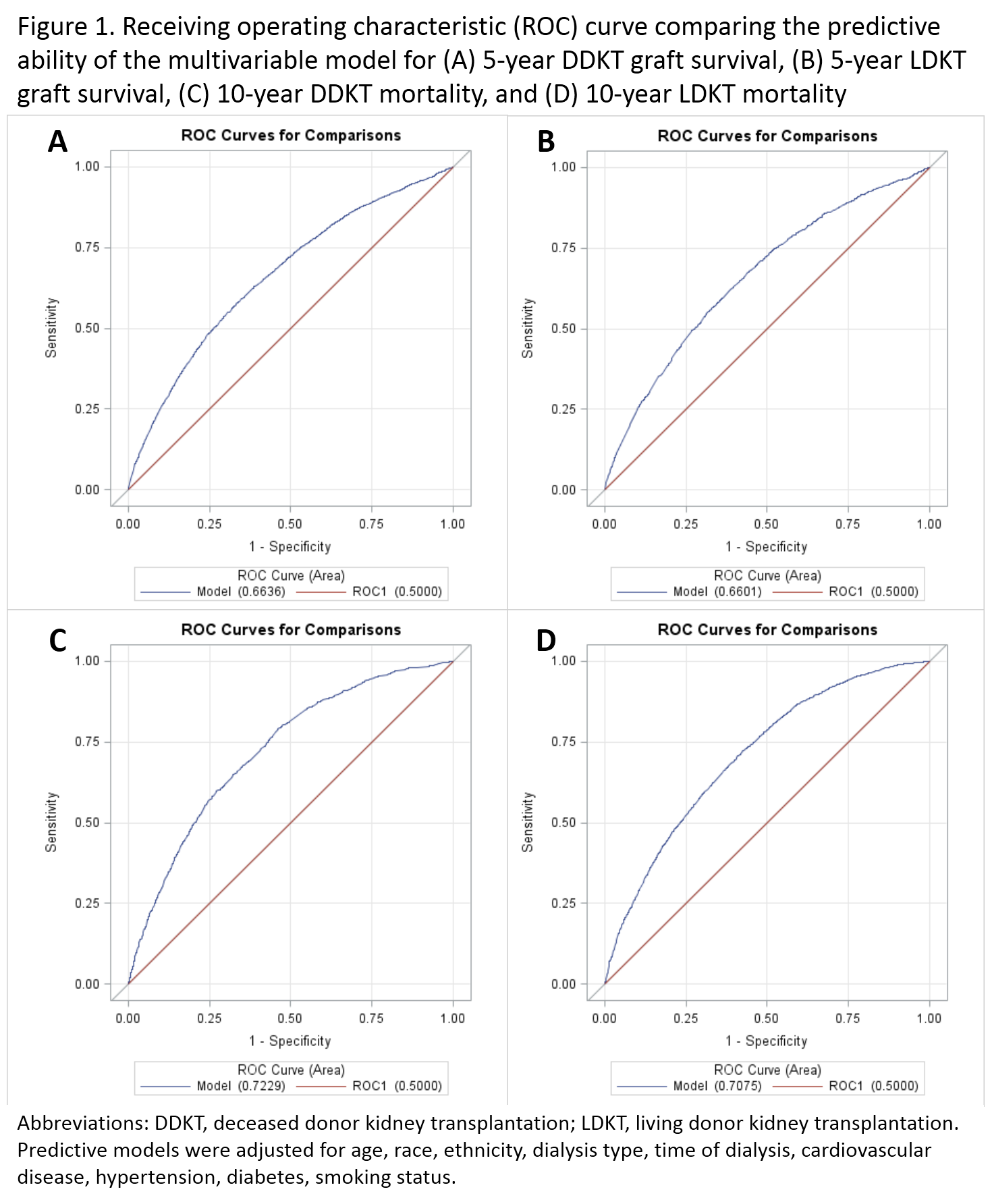Shared Decision Aid to Decipher Long-Term Treatment Risks for End Stage Renal Disease Patients.
Emory University, Atlanta, GA
Meeting: 2017 American Transplant Congress
Abstract number: D225
Keywords: Graft survival, Kidney transplantation, Mortality, Prediction models
Session Information
Session Name: Poster Session D: Living Donor Kidney Transplant II
Session Type: Poster Session
Date: Tuesday, May 2, 2017
Session Time: 6:00pm-7:00pm
 Presentation Time: 6:00pm-7:00pm
Presentation Time: 6:00pm-7:00pm
Location: Hall D1
Kidney transplantation is the preferred treatment for end stage renal disease (ESRD) compared to dialysis. The incidence of ESRD continues to increase while the gap between the number of kidneys needed and the number of organs available continues to widen. Shared decision aids are tools that may be utilized during decision making, and can be helpful to promote patient-centered care. We aimed to develop predictive models on 5- and 10-year graft survival and mortality comparing living donor kidney transplantation (LDKT) and deceased donor kidney transplantation (DDKT) to better communicate a patient's treatment specific risks.
We used the 2015 United States Renal Data System data to create a national cohort of incident ESRD patients. Patients were randomly allocated to two cohorts used to either develop or validate the 5- and 10-year survival risk prediction models for four cohorts: dialysis, LDKT, DDKT, or receipt of either a LDKT or DDKT. Potential risk factors for model inclusion were determined a priori. Adjusted survival analysis was used to develop the final, multivariable logistic regression. Receiver operating characteristic curves report the predictive power of the multivariable models.
We randomly assigned 10% of each cohort to the development cohort. Factors included in the survival prediction models for LDKT and DDKT included age, race, ethnicity, dialysis type, time on dialysis, cardiovascular disease, hypertension, diabetes, and smoking status. The discriminatory ability (c-statistic) of the 5-year DDKT graft survival was 0.6636 (95% CI 0.6548, 0.6724) and 5-year LDKT graft survival was 0.6601 (95% CI 0.6441, 0.6760), respectively. The discriminatory ability (c-statistic) 10-year DDKT and LDKT mortality was 0.7229 (95% CI 0.7103 0.7355) and 0.7075 (95% CI 0.7005, 0.7146), respectively.  The 5- and 10-year predictive models will be added to the iChoose Kidney shared decision aid that currently communicates 1- and 3-year survival estimates based on predictive models with similar predictive power. Addition of the long-term outcomes to the shared decision aid could assist educating ESRD patients on the benefits of LDKT and DDKT.
The 5- and 10-year predictive models will be added to the iChoose Kidney shared decision aid that currently communicates 1- and 3-year survival estimates based on predictive models with similar predictive power. Addition of the long-term outcomes to the shared decision aid could assist educating ESRD patients on the benefits of LDKT and DDKT.
CITATION INFORMATION: Gander J, Manatunga A, Jacob Arriola K, Pastan S, Patzer R. Shared Decision Aid to Decipher Long-Term Treatment Risks for End Stage Renal Disease Patients. Am J Transplant. 2017;17 (suppl 3).
To cite this abstract in AMA style:
Gander J, Manatunga A, Arriola KJacob, Pastan S, Patzer R. Shared Decision Aid to Decipher Long-Term Treatment Risks for End Stage Renal Disease Patients. [abstract]. Am J Transplant. 2017; 17 (suppl 3). https://atcmeetingabstracts.com/abstract/shared-decision-aid-to-decipher-long-term-treatment-risks-for-end-stage-renal-disease-patients/. Accessed December 28, 2025.« Back to 2017 American Transplant Congress
